
Super Mario Kart is a kart racing game developed and published by Nintendo for the Super Nintendo Entertainment System (SNES). The first game in the Mario Kart series, it was released in Japan and North America in 1992, and in Europe the following year in 1993. Selling 8.76 million copies worldwide, the game went on to become the fourth best-selling SNES game of all time. Super Mario Kart was re-released on the Wii's Virtual Console in 2009, on the Wii U's Virtual Console in 2013, and on the New Nintendo 3DS's Virtual Console in 2016. Nintendo re-released Super Mario Kart in 2017 as part of the company's Super NES Classic Edition.

Mario Kart 64 is a kart racing video game developed and published by Nintendo for the Nintendo 64 (N64). It is the second main entry in the Mario Kart series and is the successor to Super Mario Kart (1992) for the Super Nintendo Entertainment System. It was released in Japan on December 14, 1996; in North America on February 10, 1997; in the United Kingdom on June 13, 1997; and in Europe on June 24, 1997. It was released for the iQue Player in China on December 25, 2003. It was released on the Wii and Wii U Virtual Console in 2007 and 2016, and on the Nintendo Switch Online + Expansion Pack on October 25, 2021.

Mario Power Tennis is a sports game developed by Camelot Software Planning and published by Nintendo. The game is the sequel to the Nintendo 64 title Mario Tennis, and is the fourth game in the Mario Tennis series. Power Tennis was released for the GameCube in Japan and North America in late 2004, and in PAL regions in early 2005. The game was ported for the Wii in 2009 as part of the New Play Control! series, and was also re-released as a Nintendo Selects title in 2012. A companion handheld game, Mario Tennis: Power Tour, was also released on Game Boy Advance around the same time as the original GameCube release, bearing the same title as Power Tennis in Europe.
Super Smash Bros. is a crossover platform fighting game series published by Nintendo. The series was created by Masahiro Sakurai, who has directed every game in the series. The series is known for its unique gameplay objective which differs from that of traditional fighters, in that the aim is to increase damage counters and knock opponents off the stage instead of depleting life bars.
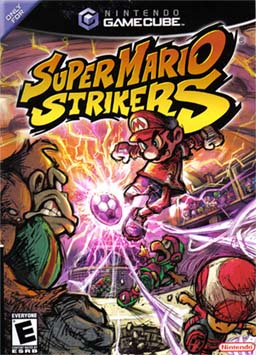
Super Mario Strikers, known in Europe and Australia as Mario Smash Football, is a 2005 sports video game developed by Next Level Games and published by Nintendo for the GameCube. The game's developers had worked on NHL Hitz Pro before development of Strikers, which served as an influence for the fast-paced and physical nature of the game. This was also the last Mario game to be released on the GameCube in Japan and North America.

Sonic and the Secret Rings is a 2007 platform game developed by Sonic Team and published by Sega for the Wii. A spin-off from the Sonic the Hedgehog series, it is the first title in the franchise for the system, and follows Sonic the Hedgehog's quest to stop an evil genie named the Erazor Djinn. In addition to the basic platforming gameplay of previous Sonic titles, Secret Rings uses a system of experience points and levels, as well as special moves that are unlocked by means of progression.

Super Mario Galaxy is a 2007 platform game developed and published by Nintendo for the Wii. It is the third 3D game in the Super Mario series. As Mario, the player embarks on a quest to rescue Princess Peach, save the universe from Bowser, and collect 120 Power Stars, after which the player can play the game as Luigi for a more difficult experience. The levels consist of galaxies filled with minor planets and worlds, with different variations of gravity, the central element of gameplay. The player character is controlled using the Wii Remote and Nunchuk and completes missions, fights bosses, and reaches certain areas to collect Power Stars. Certain levels use the motion-based Wii Remote functions.

Super Mario is a platform game series created by Nintendo starring their mascot, Mario. It is the central series of the greater Mario franchise. At least one Super Mario game has been released for every major Nintendo video game console. However, there have also been a number of Super Mario video games released on non-Nintendo gaming platforms. There are more than 20 games in the series.

Wii Music is a music video game developed and published by Nintendo for the Wii video game console. The game was released in Japan and North America in October 2008, and in Europe and Australia in the following month. Wii Music is part of both Nintendo's Touch! Generations brand and the Wii series.

Mario & Sonic at the Olympic Games is a 2007 crossover sports and party game developed by the Sega Sports R&D Department. It is the first installment on the Mario & Sonic series. It was published by Nintendo in Japan and by Sega in other regions, and released on the Wii in November 2007 and the Nintendo DS handheld in January 2008. The first official video game of the 2008 Summer Olympic Games, it is licensed by the International Olympic Committee (IOC) through exclusive licensee International Sports Multimedia (ISM), and is the first official crossover game to feature characters from both the Mario and Sonic the Hedgehog series.
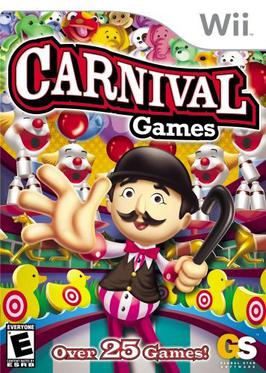
Carnival Games is a video game for Wii, Nintendo DS and iPhone, with a re-release for Nintendo Switch. It was the last game published by Global Star Software, before it was absorbed into Take-Two Interactive.

Mario Kart Wii is a 2008 kart racing game developed and published by Nintendo for the Wii. It is the sixth installment in the Mario Kart series, and was released in April 2008. Like its previous installments, Mario Kart Wii incorporates playable characters from the Mario series, who participate in races on 32 different race tracks using specialized items to hinder opponents or gain advantages. The game features multiple single-player and multiplayer game modes including two- to four-person split screen. Online multiplayer was supported until the discontinuation of Nintendo Wi-Fi Connection in May 2014. Mario Kart Wii uses the Wii Remote's motion-controls to provide intuitive and conventional steering controls. Each copy of the game was bundled with the Wii Wheel accessory to augment this feature and mimic a steering wheel.

Mario Super Sluggers is a baseball adventure video game for the Wii developed by Namco Bandai Games and published by Nintendo. It is part of the Mario Sports series, and the sequel to Mario Superstar Baseball for the GameCube. Mario Super Sluggers was released in Japan on June 19, 2008 and in North America on August 25, 2008. It was not released in Europe and Australia.

Punch-Out!! is a 2009 boxing video game developed by Next Level Games for the Wii. It is the fifth and most recent mainline game in Nintendo's Punch-Out!! series, following the SNES version of Super Punch-Out!!, and is a reboot of the series.
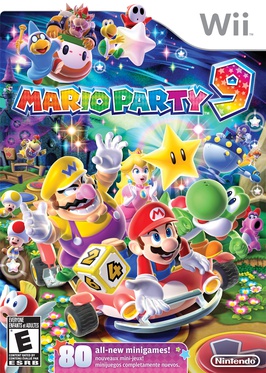
Mario Party 9 is a 2012 party video game developed by NDcube and published by Nintendo for the Wii. The ninth main installment in the Mario Party series, it was announced at E3 2011 and released in Europe, North America, and Australia in March 2012, followed by Japan a month later. It was the first game in the series not to be developed by Hudson Soft, which was acquired and dissolved by Konami on March 1, 2012, the day before the game's European release. Instead, development was taken over by Nintendo studio NDCube. This was also the final Mario game to be released on the Wii.

Mario is a Japanese multimedia franchise created by Japanese game designer Shigeru Miyamoto for video game company Nintendo, which produces and publishes its installments. Starring the titular Italian plumber Mario, it is primarily a video game franchise but has extended to other forms of media, including television series, comic books, a 1993 feature film, a 2023 animated film, and theme park attractions. The series' first installment was 1983's Mario Bros., although Mario made his first appearance in 1981's arcade game Donkey Kong and had already been featured in several games of the Donkey Kong and Game & Watch series. The Mario games have been developed by a wide variety of developers, including Nintendo, Hudson Soft, and AlphaDream. Mario games have been released almost exclusively for Nintendo's various video game consoles and handhelds, from the third generation onward.
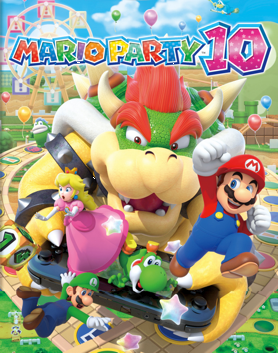
Mario Party 10 is a 2015 party video game developed by NDcube and published by Nintendo for the Wii U video game console. It is the tenth home console release in the Mario Party series and a part of the larger Mario franchise. Featuring gameplay similar to the prior series entries, players compete against each other and computer-controlled characters to collect the most mini-stars, traversing a game board and engaging in minigames and other challenges. There are multiple game modes, including one where players traverse a board in a vehicle, sabotaging each other and making choices to collect the most mini-stars by the end. Mario Party 10 adds two modes over its predecessors: Bowser Party, where four players compete in a team against a fifth who controls Bowser on the Wii U GamePad, and Amiibo Party, where players use Amiibo figures. Their gameplay is interspersed by over 70 minigames with various play styles.

Mario Tennis: Ultra Smash is a 2015 tennis video game in the Mario Tennis series developed by Camelot Software Planning and published by Nintendo for the Wii U, released internationally in November 2015, and released in Japan in January 2016. It is the first Mario Tennis game to feature simultaneous online worldwide multiplayer. The game received mixed reviews from critics; it was criticized for a lack of additional modes, its smaller character roster than prior entries, and a perceived lack of enough innovation, with many deeming the game to be inferior to previous installments in terms of content, although its visual presentation, gameplay, and multiplayer were praised.
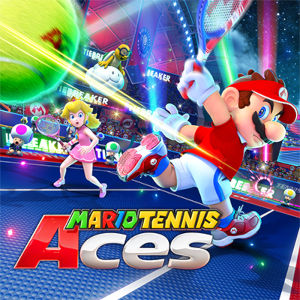
Mario Tennis Aces is a 2018 tennis game developed by Camelot Software Planning and published by Nintendo for the Nintendo Switch. The game is part of the Mario Tennis series and sold over four million copies by the end of 2021, making it one of the best-selling games on the Switch. The game received generally favorable reviews from critics.
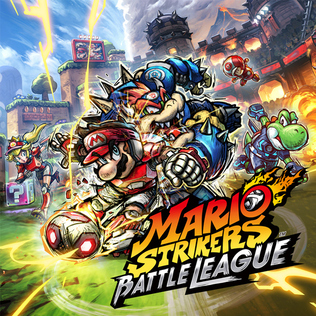
Mario Strikers: Battle League is a 2022 sports video game developed by Next Level Games and published by Nintendo for the Nintendo Switch. It was released worldwide on June 10, 2022. It is the third game in the Mario Strikers series. The game received mixed reviews, with critics praising its gameplay mechanics, multiplayer, and presentation, though it received criticism for its scarce launch character roster as well as lack of single player content.





















